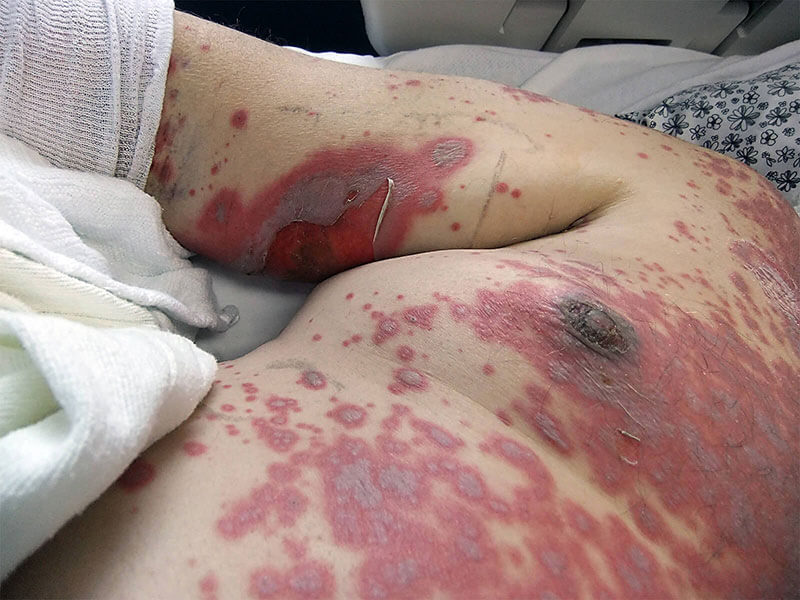Stevens-Johnson Syndrome and toxic epidermal necrosis (SJS/TEN) are very serious skin peeling conditions that are caused by an allergic reaction to medications or an illness. Hospitalized treatment includes stopping the problem medication, replacing electrolytes, applying skin dressings, and providing pain medications and antibiotics.

Stevens-Johnson syndrome (SJS) and toxic epidermal necrolysis (TEN) are serious skin conditions that cause your skin to develop rashes, blisters, and then peel. Your mucus membranes, including your eyes, genitalia and mouth, are also affected. If you get this condition, you’ll likely be admitted to a hospital.
Some people consider SJS and TEN to be different diseases, while others consider them to be the same disease but at different levels of severity. SJS is less intense than TEN. (For instance, skin peeling might affect less than 10% of the entire body in SJS, while skin peeling affects more than 30% of the body in TEN.) However, both conditions can be life-threatening.
Cleveland Clinic is a non-profit academic medical center. Advertising on our site helps support our mission. We do not endorse non-Cleveland Clinic products or services. Policy
Yes. It is also known as Lyell’s syndrome, Stevens-Johnson syndrome/toxic epidermal necrolysis, and Stevens-Johnson syndrome toxic epidermal necrolysis spectrum. It might be called drug-induced Stevens-Johnson syndrome or mycoplasma-induced Stevens-Johnson syndrome if it’s linked to a specific cause.
Many cases of SJS happen in children and adults younger than 30 years old, but also occur in others, especially the elderly. More cases of SJS occur in females than males. Infections, like pneumonia, are the most likely cause of SJS in children, whereas medications are the most likely cause of SJS/TEN in adults.
A combination of factors is likely involved in developing these disorders, including a genetic bias. Environmental factors might cause the gene to be triggered. One of these genetic factors include specific human leukocyte antigens (HLAs) that may increase one’s risk of developing SJS or TEN.
Symptoms of Stevens-Johnson syndrome include:
Causes of Stevens-Johnson syndrome include:
If your case of SJS is caused by a drug, symptoms appear about one to three weeks after you start taking medication. The flu-like illness (fever, cough and headache, skin pain) is followed first by a rash and then peeling. In the case of TEN, some people even lose hair and nails.
Medications most likely to cause Stevens-Johnson syndrome include:
You are at greater risk of SJS if you have the following conditions:
Healthcare providers diagnose SJS and TEN:
Treatments for Stevens-Johnson syndrome include:
The most severe complication of SJS and TEN is death. Death happens in about 10% of cases of SJS, and about 50% of TEN. Other complications could include:
No. Since Stevens-Johnson syndrome is, in most cases, triggered by medications, there’s no way to know – before taking medications – that you might experience an adverse reaction to the drug. If a medication is identified that has triggered this condition, you will want to avoid that drug or related drug again.
Each person’s experience with Stevens-Johnson syndrome can be different. Skin can regrow in a matter of weeks, but recovery can take months if symptoms are severe. Some long-term reactions may develop, including:
SJS may redevelop if you are exposed to the same medication known to have triggered the condition the first time. In such cases, the second episode is usually more severe than the first episode.
SJS results in death in 10% of patients and in 30% for those with TEN – due mostly to sepsis, acute respiratory distress syndrome and multiple organ failure.
Last reviewed by a Cleveland Clinic medical professional on 12/18/2020.
Learn more about our editorial process.
Cleveland Clinic is a non-profit academic medical center. Advertising on our site helps support our mission. We do not endorse non-Cleveland Clinic products or services. Policy